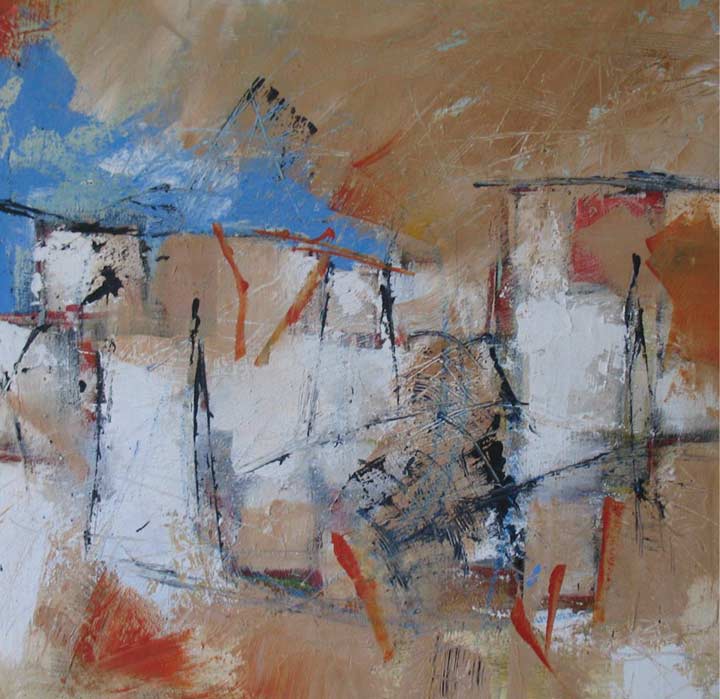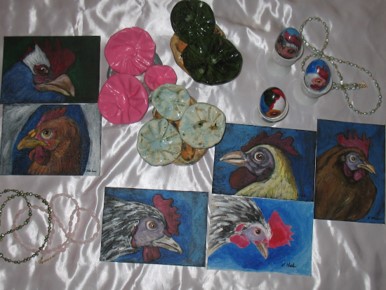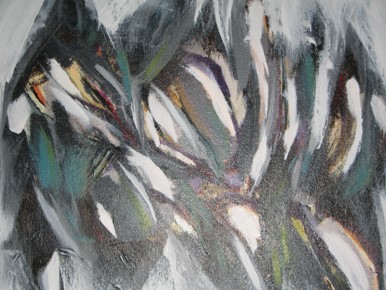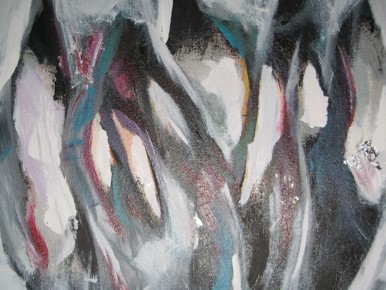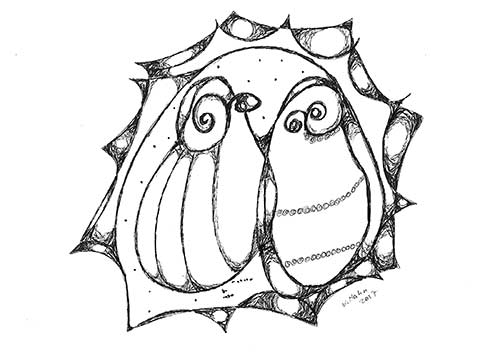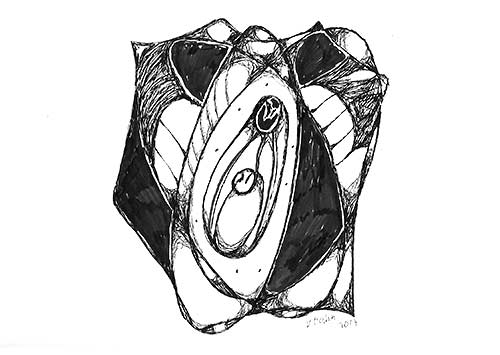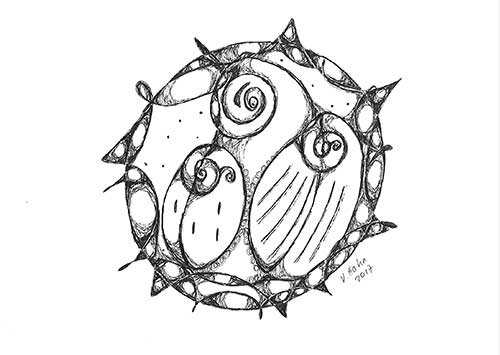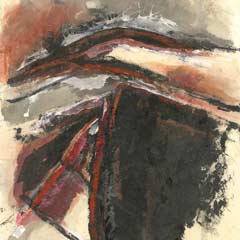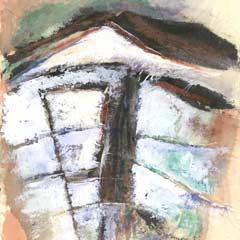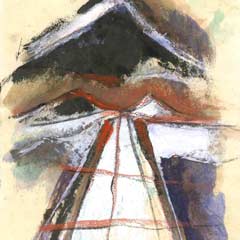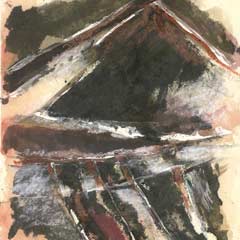Archive

Veronique Hahn, a Swiss-American, was born in Casablanca, Morocco and grew up in several countries including Morocco, Switzerland, the USA and The Netherlands where she received a Bachelor degree from the Hogeschool voor de Kunsten in Arnhem. Veronique Hahn’s art is influenced by the many cultures she grew up in.
She is mainly known for her abstract expressionist art which is based on nature/natural elements, such as, for example, roses and shells. She explores geometrical forms and lines that she perceives as rooted in ornamental decorative art, design and calligraphy, but within an intellectual interpretation and her own cultural world context. Her interpretation is based on life experiences and multi-intercultural influences.
Animals also play an important role in her art. In many cultures around the world, art and writing play an essential role in expression of thoughts and feelings. Her cross- and intercultural art and writing are full of symbols and reflect the philosophical search for the best in every culture in the world.
Veronique Hahn is author and illustrator of the fictional children’s books Hisham-the Little Scorpion-a Magical Story: Leila the Magical Spider; Zara and the Magical Slippers; Rachel and the Moon; A Wonderful Treasure; Nadia’s Famous Dish; Mother Universe-Madre Universo; A Bird within my Soul-A Journey; and other books. She has illustrated and co-authored Yasmin and Zara the Magical Bee; A Small Paradise in the Community; Katrin, the Stubborn Little Witch and Wealth. She is illustrator of the books After School and At my Grandmother’s House-En casa di mi abuela. She created the drawings for the book Ink Reactions/ Reacciones en tinta, a collaborative surrealist work with a poet/writer Rebecca Bowman.
Veronique Hahn has exhibited her art works in several countries, such as in France (Paris, Strassbourg), Germany (Berlin, Mannheim, etc.), Switzerland(Zurich, Geneva, etc.), Austria (Innsbruck) and across the USA. Her first art show was in Switzerland in 1995.
Influences are Abstract Expressionism, Surrealism and Bauhaus.
Left: Shell 5, 2003

12” x 12”, Mixed Media on Canvas, 2019

12” x 12”, Mixed Media on Canvas, 2019

6” x 6”, Mixed Media on Canvas, 2019

6” x 6”, Mixed Media on Canvas, 2019

7” x 5”, Watercolor, 2017







 Veronique Hahn was born in Casablanca, Morocco and grew up in several countries including Morocco, Switzerland, the USA and The Netherlands where she received a Bachelor in Fine Art from the College of Higher Education for the Arts in Arnhem. Veronique Hahn’s art is influenced by the many cultures she grew up in.
Veronique Hahn was born in Casablanca, Morocco and grew up in several countries including Morocco, Switzerland, the USA and The Netherlands where she received a Bachelor in Fine Art from the College of Higher Education for the Arts in Arnhem. Veronique Hahn’s art is influenced by the many cultures she grew up in.
She is mainly known for her abstract art which is based on nature elements, such as for example roses and shells. She explores geometrical forms and lines that she perceives as rooted in ornamental decorative art and calligraphy, but within an intellectual interpretation. Her interpretation is based on life experiences and multi-intercultural influences. Lines and geometrical forms refer to boundaries that have to be rediscovered within a new interpretation. Animals also play an important role in her art.

In many cultures around the world, writing plays an essential role in expression of thoughts and feelings. Her cross- and intercultural art and writing are full of symbols and reflect the philosophical search for the best in every culture (in the world).
Veronique Hahn is author and illustrator of the fictional children’s books Hisham-the Little Scorpion-a magical story: Leila the Magical Spider; Zara and the Magical Slippers; Rachel and the Moon; A wonderful treasure; Nadia’s Famous Dish; Mother Universe-Madre Universo; A Bird within my Soul-A Journey; and other books. She has illustrated and co-authored Yasmin and Zara the Magical Bee; A small Paradise in the Community; Katrin, the Stubborn Little Witch. She is illustrator of the books After School and At my Grandmother’s house-En casa di mi abuela.
Veronique Hahn has exhibited her art works in several countries, such as in France (Paris, Strassbourg), Germany ( Berlin, Mannheim, et al.), Switzerland(Zurich, Geneva, et al.), Austria (Innsbruck) and across the USA. Her first art show was in Switzerland in 1995.
 Veronique Hahn, a Swiss-American Citizen, was born in Casablanca, Morocco. She grew up in different countries such as Morocco, Switzerland, the USA and Holland, where she obtained her Bachelor of Fine Arts from the College of Higher Education for the Arts in Arnhem, Holland. Her works reflect her inter-and multi-cultural philosophical search for the best in every culture (in the world). Her first Art Show was in 1995 in Switzerland.
Veronique Hahn, a Swiss-American Citizen, was born in Casablanca, Morocco. She grew up in different countries such as Morocco, Switzerland, the USA and Holland, where she obtained her Bachelor of Fine Arts from the College of Higher Education for the Arts in Arnhem, Holland. Her works reflect her inter-and multi-cultural philosophical search for the best in every culture (in the world). Her first Art Show was in 1995 in Switzerland.
Veronique Hahn likes to work cross-culturally. Her writings and art are dedicated to the “reflection of an inner world”. The interpretation of each artwork depends on the spectator. Each spectator will perceive something unique, based on his or her life experience. Veronique Hahn is also in search of a universal language, which is based on her experience in different cultures, and yet remains unattached at the same time. Nature elements like roses, for example, can have different meanings in different cultures, and yet its beauty and form can also be seen without cultural context. The rose can be interpreted as a symbol of love, or of an endless developing/emerging world.
Arabic designs and ornamental and geometrical forms have always fascinated her. She loves to interpret geometrical forms and their design with an own “cultural world context”. In her interpretations, lines and squares can be seen as symbols for limits and boundaries that have to be re-discovered within the arts and thoughts all over again. Interpretations are part of a process based on life experience and knowledge. These forms that are sometimes presented in a more abstract way are part of her “Inner Landscape” series. Her more illustrative art falls more under “Tales within my Soul”. Animals have been a topic of Veronique Hahn’s artworks for years, as well as colors and forms.
 In the Arabic as well as in other cultures, writing plays an essential role in the expression of the arts. Veronique Hahn does not only use writing to express her thoughts, but also painting and drawing transforming her thoughts into pictures on canvas or paper. An art critic once defined Veronique Hahn’s art as “invisible writing”, although occasionally she uses poetry within the artwork to enhance a thought that she would like to share.
In the Arabic as well as in other cultures, writing plays an essential role in the expression of the arts. Veronique Hahn does not only use writing to express her thoughts, but also painting and drawing transforming her thoughts into pictures on canvas or paper. An art critic once defined Veronique Hahn’s art as “invisible writing”, although occasionally she uses poetry within the artwork to enhance a thought that she would like to share.
Veronique Hahn has exhibited in several countries, such as in France (Paris, Strassbourg), Germany (Berlin, Mannheim, et al.), Switzerland (Zurich, Geneva, et al.), Austria (Innsbruck) and the USA. She currently has work on display in New York City; Rocheport, Missouri; Westfield, New Jersey; and San Marcos, Texas. 
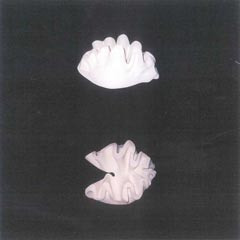
She is author and illustrator of the children’s books Hisham, the Little Scorpion;, Leila, the Magical Spider; Zara and Magical Slippers; and Rachel and the Moon. She has illustrated and co-authored Yasmin and the Zara the Magical Bee.
Veronique Hahn’s stories are full of symbols and hidden cultural treasures that she manages to give a unique everyday based life interpretation, and as already states she is in the philosophical search for the very best of every culture in the world.
Veronique Hahn also likes to paint life events on wooden boxes and wooden eggs such as a wedding, a baby, an anniversary, or just a portrait of a loved one or animals (pet).
Veronique Hahn, Copyright San Marcos Texas 2011, September 24
Veronique Hahn, Possessor of the Duende
by Rebecca Bowman

Veronique Hahn is presently working on a new series, Canciones de mis sombras/Songs of My Shadows, that incorporates new and old works, a series that, even as it comes from an established artist, shows a leap forward into a fresh perspective. This series includes oil paintings, watercolors, mixed media and ceramic masks.
Of Swiss origin, Veronique Hahn was born in Morocco and spent her childhood there, though she lived in many other countries besides. Of Swiss-German, Ukrainian and Andalusian ancestry, she draws from all of this an ageless stance, rooted in many cultures. This artist has what Federico García Lorca called el duende, the ability to capture that magic that does not come from invented spells but from the Earth itself.
Her compositions are sophisticated but do not suffer from the dimming veil of the cultured. Instead they have the simplicity and wisdom of childhood and the universal.
Notable in this series are the figurative paintings in which the field is completely flattened and there are stylized figures that might be human or ancient deities. In a flat black over a cream colored background, the figures themselves remind one of the drawings on ceramic vases in all of the Greek and African cultures, and yet the decorative elements of the paintings bring the viewer back to childhood, to play. They are happy, but somewhat muted colors, colors that lift the spirit yet are also calm, tranquil, serene.
The figures themselves in their black tones and their smooth texture are related to Oaxacan ceramics. The background reminds one in its color of the bark cloth of the Mayan codices. Over these figures and in other canvases, Hahn has placed decorations essential to the composition, shell and meander shapes that remind one of age old cultures, of the House of Shells in Salamanca, of Greek borders and the symbol for “the flower and song” in the pre-Columbian codices. Many of the figures wear headdresses or ornate hairstyles that seem to hold special meanings that for us will remain a mystery.
Even though all of these works are rooted in the ancient, the freshness of Hahn’s colors and her confidence of line reflect something of childhood, the important doings and safety of childhood, when one does not waver in play and creativity. That is why I write of Lorca’s duende, that vibrates with our ancient Earth but is always new.
 Other paintings in this series are of imaginary animals. These share with the other figured paintings the same happy, serene colors, but are even more playful and joyful. Here is the game of finding more than one animal and the surprise of not knowing which way the painting should be hung. Also very stylized, these have the same strength of line, the same bold but calm contrasts, the confidence of an artist with a long trajectory.
Other paintings in this series are of imaginary animals. These share with the other figured paintings the same happy, serene colors, but are even more playful and joyful. Here is the game of finding more than one animal and the surprise of not knowing which way the painting should be hung. Also very stylized, these have the same strength of line, the same bold but calm contrasts, the confidence of an artist with a long trajectory.
Some of the paintings in the series are abstracted landscapes, seascapes and cityscapes. These paintings that are like views that through the eye’s determination have become abstract struck the target in both color choice and composition. They are paintings with which one can live, in which one can see new elements every day, that, like a good book, can be reread many times. More roughly textured, one can enjoy the forms and values or instead fall into the painting, transported into a desert place on the seashore or a bit of the sea. The buildings one sees could be those of a Middle Eastern country but also those of our beloved Latin America. Regardless, they are part of an imaginary landscape we already hold within.
Besides the oils, the watercolors, and the mixed media works, Hahn includes several of her ceramic masks, with their age-old gestures, playful and magic.
There is a generosity of spirit in this set of works; it is a personal vision, but it gives itself up to and melts into that of all of humanity. The artist leaves the isolation of particularity to connect to and express the communal, and in doing this shows a classicism of the finest.
To see something new but with firm roots in the ancient, one need look no further than the new series of oil paintings, watercolors, mixed media and masks by Veronique Hahn, a painter, poet and sculptor of artistic maturity.
Veronique Hahn, poseedora del duende
por Rebecca Bowman
En este momento Veronique Hahn está trabajando una nueva serie, Canciones de mis sombras/Songs of My Shadows, que incorpora nuevas y viejas piezas, una serie que, aun viniendo de una artista ya establecida, muestra un avance notable hacia una perspectiva innovadora. Esta serie incluye óleos, aguatintas, medios mixtos y máscaras de cerámica.
Hahn es de origen suiza, pero nació en Marruecas y vivió ahí su infancia, aunque también residió en otros países. De herencia suiza-alemana, ucraniana y andaluza, toma de todo esto una posición milenaria, enraizada en múltiples culturas. Esta artista tiene lo que llamaba Federico García Lorca “el duende”, una capacidad de captar esa magia que proviene no de conjuros inventados sino de la misma Tierra.
Sus composiciones son sofisticadas, pero sin adolecer el velo distanciador de lo culto. Más bien poseen la sencillez y sabiduría de la infancia, de lo universal.
En esta serie son de notarse los cuadros figurativos en donde el campo pictórico se aplana y hay figuras estilizadas ya bien de humanos o de antiguos dioses. De tono negro mate sobre un fondo color crema, las figuras en sí recuerdan a los dibujos sobre cerámica de todas las culturas griega y africanas; sin embargo, la paleta que usa Hahn remonta a lo infantil, al juego. Son colores alegres, pero algo mitigados, colores que levantan el espíritu pero que son a la vez calmados, tranquilos, serenos. Las figuras principales se relacionan en su tonalidad negra y su textura lisa con la cerámica de Oaxaca. El fondo recuerda al papel amate color cremoso de los códices mayas. Sobre estas figuras y en otros de sus lienzos se ven decoraciones de gran importancia en la composición; caracoles y los espirales griegos que acuerdan también a las culturas milenarias, las conchas de la Casa de Conchas de Salamanca, los meandros griegos, la voluta que representa el flor y canto en las culturas precolombinas. Muchas de las figuras llevan o tocados o peinados altamente adornados que parecen tener un significado especial pero que para nosotros seguirán siendo un misterio.
Aunque hay en las obras de Hahn raíces en lo antiguo, la frescura de sus colores y la confianza de sus trazos reflejan algo de la niñez, el quehacer y la seguridad de la niñez, que no duda en su juego y su creación. Por eso escribo del duende de Lorca, que vibra con la Tierra antigua, pero que es siempre nuevo.
Otros cuadros en esta serie son de animales imaginarios. Comparten con las figuras los mismos colores vivos y serenos, pero parecen más juguetones, más alegres aún. Está el juego de descubrir más de una figura y la sorpresa de no hallar por dónde va el cuadro.
También muy estilizados, tienen la misma firmeza de línea, el mismo contraste, fuerte pero tranquilo, y la confianza de una artista de larga trayectoria.
Algunos cuadros en la serie son como paisajes rurales, marinos y citadinos abstraídos. Estos paisajes vueltos abstracciones por la voluntad del ojo de Hahn son de composición y colorido atinados. Son cuadros con los que uno puede convivir, en que pueden verse nuevos elementos todos los días, cuadros que, como un buen libro, aguantan múltiples lecturas. De una textura más ríspida, uno puede recrearse en las formas, pero también se adentra uno en el cuadro, se transporta a un lugar desértico a la orilla del mar o un trozo del mismo mar. Los edificios que se vislumbran pueden ser o bien de un país medio oriental o bien de nuestro querido Hispanoamérica. No obstante, son también de un paisaje imaginario que ya llevamos dentro.
Además de los óleos, aguatintas, y cuadros de medios mixto, Hahn incluye varias máscaras de gesto antiguo, juguetonas y mágicas.
Hay una generosidad de espíritu en este conjunto de piezas; es una visión personal pero que se entrega a y se funde con toda la humanidad. La artista deja el aislamiento de la particularidad para ligarse a lo comunal y expresarlo, y en eso muestra un clasicismo de lo más fino.
Para ver algo nuevo, pero con firmes raíces en lo antiguo, no hay que buscar más allá que la nueva serie de Veronique Hahn, una pintora, poeta y escultora de madurez artística. Posted January 2016
